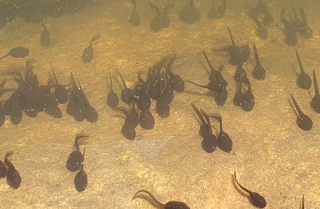New Timing for Frog Spawning Raises Concerns in Gimhae: A Climate Crisis Effect?
In an unusual turn of events, the valley mountain frogs in Daecheong Valley, Gimhae City, Gyeongnam Province, have defied their traditional spawning schedule, leaving environmentalists and citizens perplexed. Eggs of the valley mountain frog were spotted among fallen leaves, breaking the norm of January spawning. This premature occurrence, about two months earlier than expected, has raised alarms among ecological activists who have been monitoring the region for four years.
Witnesses reported tadpoles swimming in a nearby stream, a sight rarely seen in December. With the absence of a true winter cold wave, concerns loom over the survival of these early-hatched tadpoles. Notably, Gimhae experienced an unusually warm December, with a maximum daytime temperature of 28 degrees, marking the warmest December since observations began in 2008. The temperature dropped to a chilly 1 degree on the 13th morning, further complicating the situation.
Experts specializing in amphibians suggest that the frogs might be responding to the recent weather as a signal of an early spring, mistaking it for a post-winter scenario. The sudden temperature rise triggered the release of hormones in the frogs, prompting them to lay eggs.
Environmental groups are attributing this November frog spawning to the broader climate crisis, pointing out that mountain frogs are designated climate-sensitive indicator species by the Department of the Environment. Advocates stress the need for a comprehensive study to understand the acceleration of frog egg-laying and its potential ramifications.
Frequently Asked Questions (FAQ):
Q1: Why are valley mountain frogs spawning in November instead of January in Gimhae? A1: Experts suggest the unusual November spawning might be a response to the climate crisis, with frogs mistaking warm weather for an early spring.
Q2: How does the climate crisis affect mountain frogs? A2: Mountain frogs, designated as climate-sensitive indicator species, are showing altered spawning patterns, highlighting the broader impact of climate change on ecosystems.
Q3: What measures are being proposed to address this issue? A3: Environmental groups emphasize the need for a systematic study to comprehend the acceleration of frog egg-laying and its implications for the ecosystem.
#FrogSpawning, #ClimateCrisis, #EnvironmentalConcerns, #GimhaeNature, #AmphibianConservation

